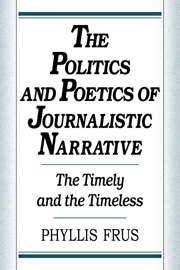Book contents
- Frontmatter
- Contents
- Preface: True Stories
- Acknowledgments
- Introduction: What Isn't Literature
- 1 Writing After the Fact: Crane, Journalism, and Fiction
- 2 “News That Stays”: Hemingway, Journalism, and Objectivity in Fiction
- 3 News That Fits: The Construction of Journalistic Objectivity
- 4 Other American New Journalisms: 1960s New Journalism as “Other”
- 5 The “Incredibility of Reality” and the Ideology of Form
- 6 Freud and Our “Wolfe Man”: The Right Stuff and the Concept of Belatedness
- Conclusion
- Notes
- Works Cited
- Index
6 - Freud and Our “Wolfe Man”: The Right Stuff and the Concept of Belatedness
Published online by Cambridge University Press: 14 September 2009
- Frontmatter
- Contents
- Preface: True Stories
- Acknowledgments
- Introduction: What Isn't Literature
- 1 Writing After the Fact: Crane, Journalism, and Fiction
- 2 “News That Stays”: Hemingway, Journalism, and Objectivity in Fiction
- 3 News That Fits: The Construction of Journalistic Objectivity
- 4 Other American New Journalisms: 1960s New Journalism as “Other”
- 5 The “Incredibility of Reality” and the Ideology of Form
- 6 Freud and Our “Wolfe Man”: The Right Stuff and the Concept of Belatedness
- Conclusion
- Notes
- Works Cited
- Index
Summary
I have now reached the point at which I must abandon the support I have hitherto had from the course of the analysis. I am afraid it will also be the point at which the reader's belief will abandon me.
– Sigmund Freud, “From the History of an Infantile Neurosis”The important triad in crime nonfiction narratives, we have noted, is made up of the criminal, the detective or prosecutor who explains the crime by reconstructing how it “must have happened,” and the journalist who reports the story, imitating or supplementing the detective by recapitulating the solution in what becomes the privileged version. When the true-crime story is self-consciously narrated, it is easily read reflexively. Such a reading is likely when the journalist's relationship to his subject forms part of the plot or when the reader begins to attend to this relationship. An implicit concern of Janet Malcolm's analysis of reporters' relationship to their subjects, in The Journalist and the Murderer, is the effect their attitude has on the depiction of character and therefore on the reader. She is aware that readers are influenced to accept or reject a narrative's truth claims by the manner in which the subject is represented. In this account of how Joe McGinniss portrayed convicted murderer Jeffrey MacDonald in Fatal Vision, she is clearly appalled that the journalist had the power to convince numerous readers of MacDonald's guilt (“If it says so in a book, it must be true” [129]).
- Type
- Chapter
- Information
- The Politics and Poetics of Journalistic Narrative , pp. 196 - 232Publisher: Cambridge University PressPrint publication year: 1994

